Introduction
In January, we started this series with an introduction into the competitive shooting world with a piece that covered some basics on safety and gear. We then followed up that initial article with one on Steel Challenge because of its low cost and slim gear requirements.
Now, after having read those two articles, you’re hopefully ready to bite the proverbial bullet and jump into shooting whole hog! One of the most popular places to do that is USPSA pistol. You’ll begin to see why in a moment, but first you can check out an overview of my series, “The Journey into Competitive Shooting.”
THE JOURNEY INTO COMPETETIVE SHOOTING
Ep. 1 Getting Started
Ep. 2 Steel Challenge
Ep. 3 USPSA Pistol
Ep. 4 Shotgun
Ep. 5 3 Gun
Ep. 6 High-Power Rifle
Ep. 7 Cowboy Action
Ep. 8 Shotgun II
Ep. 9 IDPA
Ep. 10 Bulls Eye Pistol
Ep. 11 Smallbore Rifle
Why USPSA?
USPSA pistol shooters are one of the largest actively competing groups of shooters who participate in weekly events. There are over 25,000 members and 400 local clubs across the country. According to former USPSA President Mike Voigt, “USPSA handgun is where accuracy, economy of motion, blazing speed and precise control come together.” Mike spent 12 years at the helm of the organization, and describes it as “the pinnacle of practical handgun competition, every bit as demanding of a wide assortment of skills as Formula 1 does in motorsports.“ This isn’t just someone telling you their baby is great, Mike has national and world titles in other shooting disciplines, but he calls USPSA “the pinnacle”.
So, giving that USPSA is a very demanding discipline — akin to Formula 1 — you may wonder why am I telling you that this is another great place to start? Well, because of something I talked about in the first part of this series: the people!
USPSA began with people. People who wanted to push the boundaries of shooting in the areas of self-defense and training. Due to this desire, it has grown into a testing ground for many techniques and practices that are employed by both LEO & military operatives, and many top-level USPSA shooters instruct military and law enforcement personnel. This crossover from sport to practical application is what draws people to USPSA, along with the fact that USPSA — and, the international sister sport, IPSC — employ such stringent rules. USPSA shooters are in the public eye and want to be there without drawing criticism.
But why should YOU do it? One of the reasons I love it is the fear factor. Yep, fear — of failing, of pushing myself beyond what I thought I could do, of going outside of my comfort zone, which all force me to stand back and gain a new perspective on shooting. It also forces me to think on my feet and make split-second decisions, while people are watching. And here I come back to the people, they’re your friends, family, and will laugh with you, keep you safe, and push you as much as you push yourself. I love shooting at our home club with people I know so that if I make a mistake, the pool of prospective laughter isn’t as big as a large match, but I make people laugh there as well. I also love it because it teaches me to fail; to fail over and over, and over, until I stop failing and figure things out. There are NO participation awards in shooting — well, maybe the enjoyment in the people you’re with, but when you fail, you lose or get penalties. But that’s okay, because even the last place guy generally ends up learning something to apply to a future match. So the only real losers are the people who don’t pay attention to what they’re learning. Even the pros laugh at themselves, and I’ll use my friend Maggie Reese as an example. The woman will crush you with a pistol: in open, Single Stack, Limited, you name it, and then laugh at her girly running and move on.
USPSA is a discipline where some of the biggest names in shooting, like Rob Leatham and Jerry Miculek, have made history, with feats like Jerry’s 19 USPSA National titles, or Rob’s 26 USPSA National titles. It’s also a unique mix of people that in many ways represent what the shooting community is about — people from all walks of life coming together to enjoy and become more skilled with their firearms. To gain practical skills that they can carry with them into everyday life.
What is USPSA Pistol?
It’s shooting your pistol, in one of many divisions, and doing it both fast and accurately.
Sounds simple, till you dissect it. Just the guns and gear can make your head swim in what to use and why, in which division, but you have six to choose from: Limited, Limited 10, Production, Open, Single Stack, and Revolver. You can read more about the divisions and decide which is best for you.
Dissecting further, there are variations in the type of match: level 1, 2, etc. All have different parameters for what can be in each match, from the style and number of targets to the distance requirements for placing them — all these things point to rules. USPSA has a lot of rules! So many, that if you’re serious about shooting, and participate long enough, you tend to become a Range Officer (RO). Not in a sense of knowing a lot, but literally, you take a RO class because there’s just a lot to know, rules change, and the matches have rules about who can run a timer and who can supervise (be the RO), so when a spare RO is needed, the more shooters that are certified, the better. But these rules also make it safe – they make it possible for thousands of shooters throughout the country to safely compete in matches every weekend. Just take a gander at Practiscore’s website for any given weekend and see the number of USPSA matches that are scored. It’s awesome to see those numbers, but it gives the rules that we have to abide by meaning. It’s about keeping people safe so the sport never gives gun-owners and competitive shooters a “black eye.” Individual responsibility is at the core of all that. Which is what makes this a great sport for kids, and a great sport for all gun-owners; it stresses the need to do your part, always, and to watch to make sure that others do theirs as well.
Down to the Nitty-Gritty
USPSA shooting is about being accurate, and fast, and finishing well requires a high skill level in both areas. This means efficiency of movement, no wasted steps, not even wasted movements in your eyes or fingers, etc. Everything is programmed to run; like a tape playing in your head, you walk stages, you visualize, you program a stage plan and you execute it. This leads to all sorts of catch phrases, “slow is smooth, smooth is fast” and “a perfectly executed plan is better than a perfect plan poorly executed.” You also learn what a bad idea it is to change your mind at the last second. You learn the value of thinking ahead, of planning for worst-case scenarios, of being able to think on your feet and change your plan mid-stage, while moving down range or through a course of fire – all incredibly valuable skills for LEO and military, but also for regular human beings as they navigate life. You will walk away from your first USPSA match feeling very inadequate, and yet very motivated. For me some of those first experiences were with one of the older guys at our club, we’ll call him Old Man Brimmer. He’s had knee surgery(s), he’s slow, he can’t run, but he’ll shoot Alphas all day long with a big ol’ .45 and will then laugh and take satisfaction in that he’s more accurate than all the kids running around throwing Charlies out for no good reason. And that brings us to Alphas, Bravos, Charlies, and Deltas — scoring. USPSA scoring works on time and hit factor. It’s math, if you’ve listened to me talk on podcasts, you know I’m not a fan of math, I try to avoid it, so here’s a hit factor calculator. Basically, it is points divided by time. The caliber of your pistol round also plays a role, so there is Major and Minor scoring. I just focus on shooting accurately and fast and let the scoring program work its magic. But having a basic understanding can keep you from accepting a score that’s wrong, so, at least, sanity-check what you see on your scoresheet.
Where to Find USPSA
There are USPSA matches all over the country. You can find them listed here on USPSA’s website, and you can look through upcoming matches on Practiscore. Last Sunday, their site showed 660. Practiscore is an electronic scoring program and web site that many shooting disciplines are using for online scoring. It’s a great tool, not just to find clubs, but to check your scores, sign up for matches, or host registration. Altogether, Practiscore is a time-saving dream for match directors. And for shooters, access to results by category, division, and other metrics is not just a handy tool, it’s educational. It’s actually a great way to learn about what matches are out there, and as you begin to digest all the bits and pieces on scoring and divisions, reading through results will help you grow your vocabulary. To flesh out the numbers in the opening paragraphs about USPSA’s 25,000 members, Practiscore’s largest recorded day for unique shooters scores was March 4th, 2015, with 1898 shooters scored on that day. And for 12 months, they had 35,343 unique shooters scored in USPSA. This means you’re definitely going to find a match near you!
You know what you’re doing, and where to go, now get ready!
How to Prepare
The same guidelines for starting at local matches and smaller events come into play here. Start with a reasonable event, and push yourself from there. USPSA matches at a club level are going to be what you want to begin with. You can also look for leagues, as described in the last article.
But you’ll need to read the rules on divisions and decide which to shoot in. Once you have your gear, set it up and dry fire. By dry firing, you can practice your draw, magazine changes, transitions, movement and taking your finger off the trigger and placing it outside the trigger guard, along the frame of the pistol. Whenever you move, your finger comes off the trigger! You need to practice the heck out of this! Do this over, and over, and over. It’s said that a person needs to perform at least 1,000 repetitions of a motion to develop muscle memory. And you’re not just memorizing some ethereal concept, you’re literally making a neural connection between your brain, your muscles – your hands and eyes, and you want this muscle memory to be automatic so that your conscious mind can focus on your stage plan and the things you need to execute your stage plan well. You want safety to be ingrained to the point of being automatic. That’s what keeps you and the people you’re with safe, and gives us the latitude to push ourselves like it’s a Formula 1 race!
*Remember what we said last time about EVERY time you handle your firearm, check that the gun is empty – no mag, nothing in the chamber.
To illustrate why we want to learn about making crisp and fast transitions, pay attention to the end of this video of Athena Lee and watch her speed between targets and how aggressively she drives the gun to the next target.
If you want a few other drills, check out the link at the bottom of the article.
Your goal for your first several matches should be safety. Don’t worry about burning down the stage, focus on moving safely, finger off the trigger and out of the trigger guard every time you move. Focus on keeping within the 180, and thinking through the range commands you’re given. One of the very distinct rules that all shooting sports have is concerning handling firearms under supervision, if you uncase your pistol outside of the safe area at a USPSA match, you’re going home. You CANNOT handle any firearms unless in a designated safe area, or under the supervision of a range officer. So it can be a little unnerving – learning all the rules at the same time as you’re trying to learn the game and walk stages AND help reset targets.
Etiquette: USPSA has some distinct etiquette. So again, if you can go spectate at a match, it will go a long way to making your first match easier! People who I’m calling great and welcoming will not bend on safety, and they are always very observant of new shooters. So you want to watch some videos, observe a match, participate as a spectator and really look and listen to what is happening. Ask if you can just help out and post targets and watch. You’ll be safer and it will make your learning curve less painful! Nobody likes to admonish a new shooter, but safety will override any desire to make people feel warm and fuzzy.
What You’re Doing on a Whole New Level
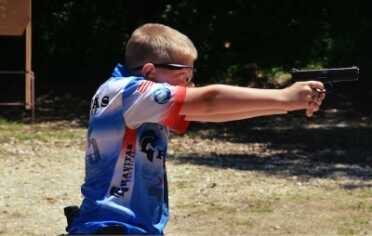
Limited Division is a great place for a junior to start shooting pistol, since the higher magazine capacity takes out excessive reloads and allows them to focus on their safety.
So you have your gear, you found a match, you practiced with dry firing, you went to the range and worked a little, you watched some matches, what else do you need to know? It’s just shooting, right? Well, here we come back to the race car again. You don’t just hop in a car and take off without knowing some basic principles! You might only drive a sporty Nissan, and don’t need to go into the amount of torque an engine has, but surely you can learn that you downshift going into a curve and accelerate going out and just the same, you can learn that you change mags at the beginning of movement so you can end the movement ready to shoot. But even before tiny details, you want some other basics.
How about some of the terms: hit factor, Virginia Count, Comstock, classifiers, field courses, there’s a lot of terms in USPSA and a huge rule book! These are all going to be terms you need to understand. I’m going to give the short version on these, so please, if you’re a USPSA rule aficionado, don’t go crazy on me – this is for new shooters to understand the game!
A field course is a stage where you are moving through a course of fire, usually lots of movement and lots of targets. These tend to be Comstock scoring, meaning you can shoot as many shots as it takes to hit the targets, or take make-up shots if you call a bad shot. Here’s a video of Mike Voigt on a field course at USPSA Nationals.
A classifier is a course of fire that measures specific skills. It’s usually short, generally no movement, or not much movement – something like moving to a forward box as you perform a mag change is pretty typical of the type of movement, if any. These are often Virginia Count stages, that means, you shoot no more than the prescribed number of shots, or you’re penalized. You sometimes have a classifier stages with steel, but those are Comstock, since steel must fall to score, and you then need to have extra rounds to engage the target again if you miss.
There are many classifier stages, and you will shoot them to earn a classification. There is a balance to speed and accuracy, just like in field courses. You can calculate your classifier scores here.
Some people seek out special classifier matches. Some people find out what the stages will be ahead of time and practice them. There are a couple terms that come into play here, and I’m going to teach you about them so you become good competitors. Sandbagging refers to shooters who purposely shoot poorly, or slowly so they don’t bump their classification up so that when they get to a big match, they can reap the benefit of performing well in a classification below their actual skill level. Sometimes this happens just because they can’t get to classifier matches and they improve quickly. Shooters joke about this, but it doesn’t happen intentionally all that often. The other term is grandbagging, and refers to the shooters who will shoot a classifier stage over and over to get the score they want to bump themselves up into a higher classification. Sometimes that means they will shoot and ask for only the best score to be entered. This accounts for the Master class shooters who get stomped on by B and A class shooters in a match. Don’t be a grandbagger – everyone recognizes that they’re race car drivers who can only drive their special gun, in their small realm of comfort, but once they step outside of it into a real deal match, their fancy race car and card can’t help them. Be a muscle car! This is a muscle-car, Athena Lee, a pistol-shooting extraordinaire and all around badass. She shoots with both muscle-car power and at other times, graceful agility.
So as you start out on this adventure, power through everything and make a little noise as you go, even if it’s loud and not always graceful, because once you get warmed up, you can lay on the gas and blow by the cars that are just for looks.
The Finish Line!
I have a different goal when I shoot than most shooters, even most women shooters – I’m bringing kids along with me. My 3 boys all compete, and they’re doing so at a level that isn’t just ho-hum, I have one junior national champion in Bianchi Cup, and the younger two are at a respectable skill level for their ages. But more than anything, I want them, and YOU, to take away the life lessons that competition shooting brings to the table. I want you to learn how to think on your feet, how to think for yourself and not follow the crowd of 10 shooters who shot the stage the same way before you, I want you to help out and engage with others, I want you to stay safe and help others stay safe. Basically, I want to ensure you turn into a capable human being who can actively participate and not just consume. I want you to race, and make it to the finish line with respect. Don’t just read about shooting and guns, don’t just buy the cool gear, get your butt out there and do something!
Bonus Material:
Want some really detailed info on the draw? Watch Mike Seeklander’s video. Mike is a great instructor, and if you can ever take one of his competition pistol classes, do it! I want to take another because I learned so much in the first class! He even gave me a code so you guys can watch one of his videos from his Vimeo channel. If you watch the “Static Draw, Varied Target” drill, you’ll know more about the draw than most people. The code to use is “becky”, and this link should take you right there.
About the author: Becky Yackley has been shooting competitively since she began as a teenager with service rifle and smallbore. She’s lived near the typical Marine Corps bases and spent 10 years near DC while her husband was active duty, but has settled into Wisconsin and shooting 3 Gun, USPSA, and Bianchi pistol with her three boys and husband. An avid runner and outdoorswoman, she shoots guns and photos, and sometimes her mouth…which her friends often remind her keeps them “alert” at late hours on road trips. Never known for being quiet, she’s bringing her brand of humor our way this year in hopes of sharing her love for shooting sports with our readers.

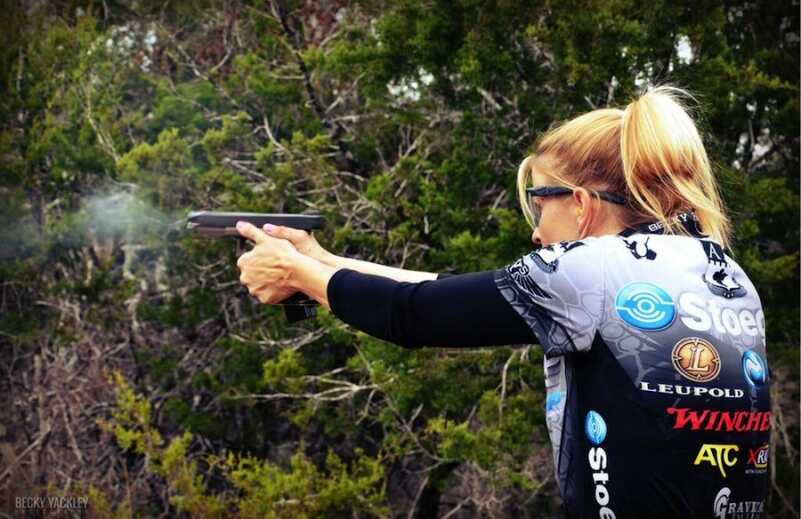

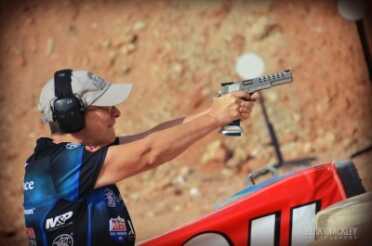
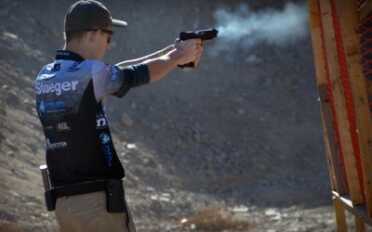
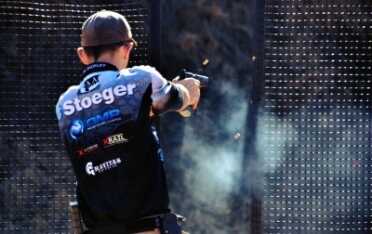
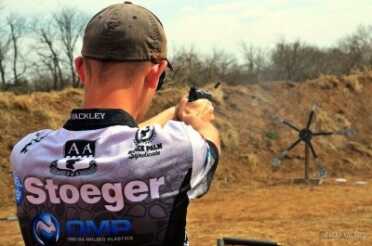

Great series Becky…very much appreciated by a newbie to shooting sports. I’ve read every word so far, and coming from someone who is gearing up to start USPSA, I can say that you’re spot-on with your guidance to new shooters. I’ve gotten my feet wet already (barely!) and find competitive shooting sports to be very welcoming to new shooters. Now if ammo only grew on trees…
Love these articles and the videos! Thanks for putting these together.
V/ r
Chris
Too bad she doesn’t know proper range commands.
Make ready, Are you ready?, Stand by. Start signal. If you are finished, unload and show clear. If clear, hammer down, holster. Range is clear.
Lol, thanks Ray. You probably read the part about USPSA having a lot of rules, and there’s definitely folks who love their rules and phrasing. But many ROs still use, “Load and make ready”, and a whole lot of other phrases. The reason I even tried to incorporate some range commands was to 1) give a new shooter an idea of what will be going on around them and make them aware that they’ll be interacting with an RO, and 2) highlight that they need to listen to what they’re being told and UNDERSTAND it. It doesn’t matter if it’s “load and make ready”, “going hot, load up”, “alright, make ready, going hot”, “gas it up”…if you’ve shot disciplines outside of USPSA, I’m sure you’ve run into some humorous variations. And the real intent of the RO and range commands is to keep everyone safe.
And to be honest, I think “load and make ready” holds at clear “load” command, whereas if a person is double plugged on hear pro, they could mistake an RO asking “are you ready” for “make ready”. I think hearing “load” holds less potential for trouble, just my opinion. So I don’t mind it at all when people use “load and make ready” because I am wearing hearing protection, and when I hear load, I know they intend me to load.
Here’s an official list of range commands:
The Range Officer (RO) is the match official in charge of competitor action on a stage. This official ensures that competitors comply with the stage instructions safely. The Range Officer stations himself/herself in close proximity to the competitor to issue the range commands and oversee safe competitor behavior.
Now it is your turn to shoot. You step up to the line and wait for the Range Officer’s commands. Here is what you should hear:
“Range is Hot” Optional Command to signal to spectators that the course of fire will begin soon.
“Make Ready” The competitor faces down range and prepares the handgun (in most cases this is where the handgun is loaded) in accordance with the written stage briefing. The competitor then assumes the required ready (start) position. If you have any questions about the stage, ask the Range Officer before you prepare your handgun, this is also the time to take a sight picture with an unloaded handgun. Good protocol is to ask the RO if you can take a sight picture.
“Are You Ready?” You have several options at this point. First, if there is a lack of any negative response, the RO will assume you are ready. Second, you can say nothing, “ready” or nod your head up and down. Third, you must shout “Not Ready” or give a clear indication you are not ready to go otherwise the RO will continue.
“Standby” This command will be followed by the start signal within 1-4 seconds. If you move after the “Standby” command and before the start signal you could be assessed a procedural penalty for “Creeping”.
“Start Signal” The audible or visual signal to begin the course of fire.
“Stop” This command may be issued by range officials at any time during the course of fire. The competitor shall immediately cease firing, stand still and wait for further instructions from the Range Officer.
“If You Are Finished, Unload and Show Clear” When the Range Officer issues this command and the competitor has finished the course of fire, the competitor shall lower his/her handgun, drop the magazine, unload the chamber and hold the handgun open for inspection by the RO.
“If Clear, Hammer Down, Holster” This command is given after the Range Officer is satisfied that the handgun is unloaded and safe for further action (holster or bag). At some clubs a competitor can either holster or bag his/her handgun upon this command due to weather. Major matches usually require competitors to come to the line with his/her handgun holstered. If that is the case you must bag and un-bag at a Safety Area if you don’t want to carry your handgun in the holster between stages.
“Range is Clear” The competitor, range officials and other squad members now go down range to score, tape and set targets. This command signifies that the live fire portion of the stage is over for you. You should always follow the RO when your targets are scored, just to verify scoring.
Using proper range commands is important for consistency. In major matches where the competitors may not speak English, they will be able to understand the commands if they stay consistant. It’s a professionalism thing. Yes, I am an RO. I am part of a team that runs a monthly match in Creedmore, NC. Yesterday we had 118 competitors including 7 Grand Masters and 2 reining USPSA national champions. I like to think that our professionalism attracts this level of competition.
If you are ever in the area on the 1st Saturday of the month, come shoot with us.
Very Interesting. I am looking into getting started with rifle competition vs handgun, so I am really looking forward to episode 7 (I believe) that deals with rifle competition. Keep up the good work.
PJ,
Check out US Carbine Association matches… There’s a rifle match in May at Peacemaker National Training Center in WV. Then Hiperfire has a rifle match…last year it was in Oct in NC. The article will focus on High Power Rifle (National Match course) and other areas of long range rifle.
There is a USPSA rifle match at Sir Walter Gun Club in Creedmore, NC every 5th Saturday.
It’s like USPSA pistol but with rifles.
One of the best articles I’ve ever read for the new competitor, and anyone for that matter. Thanks for all the great info. I will definitely share with everyone.
Very nice Becky! I am really enjoying this series, and looking forward to shooting with you and the family this year.
Thanks Clay! Warsport match? Sean’s getting hit up for a partner 🙂